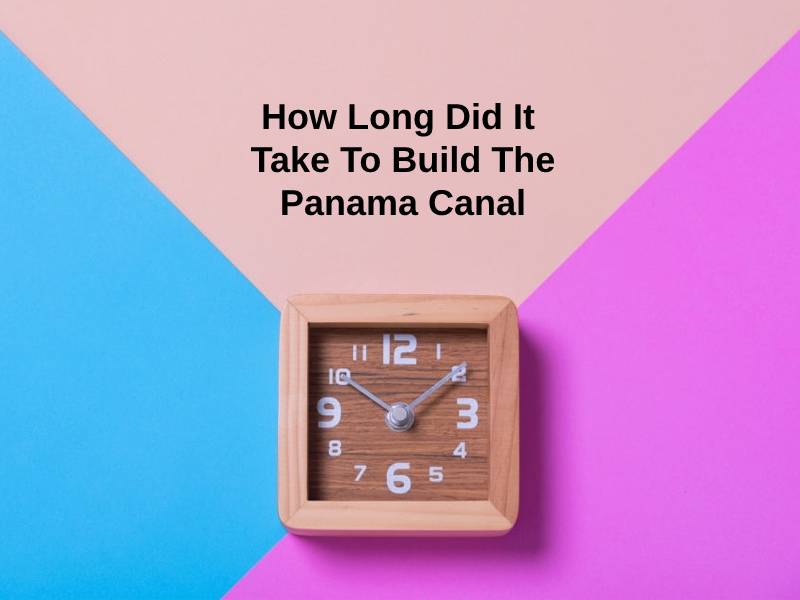Exact Answer: 10 years
The Panama Canal is considered one of the greatest inventions and discoveries of the twentieth century. This not-so-insignificant piece of infrastructure covers the Isthmus of Panama, connecting the Atlantic and Pacific Oceans and saving time and money for governments and businesses all over the world.
The Panama Canal is a waterway that runs across the Isthmus of Panama, built first by France and subsequently by the United States. The canal is a 50-mile-long channel that allows ships to bypass the long and dangerous Cape Horn route around South America’s southernmost tip, as well as the even less popular route across the Arctic Archipelago and the Bering Strait.

How Long Did It Take To Build The Panama Canal?
| What happened | When happened |
| Construction started | 1904 |
| Construction ended | 1914 |
The French started construction on the canal in 1881 but were unable to complete it owing to sickness and construction problems. The canal was started in 1904 by the United States. The canal was finally inaugurated on August 15, 1914, after ten years of arduous effort.
The Panama Canal was constructed to reduce interference, expense, and time taken for ships to transport freight between the Atlantic and Pacific Oceans. Ships had to circumnavigate South America before the canal was built. Crossing the canal saved a ship heading from New York to San Francisco, 8,000 miles and 5 months of journey time. The Panama Canal gave the world’s economy and trade a significant boost.
Since the Isthmus of Panama is a relatively short strip of land between the two seas, it was chosen as the location for the canal. Although the canal remained a massive technical endeavor, here was the “easiest” location to construct it.
Thousands of employees from all around the world contributed to the canal’s construction. As many as 45,000 men were participating in the project at one stage. The canal was sponsored by the United States, and the canal’s principal engineers were also Americans. They included men like John Stevens, who persuaded President Teddy Roosevelt that the canal needed to be raised, William Gorgas, who devised mosquito-killing methods, and George Goethals, who oversaw the project from 1907.
The canal was built for $375 million. In today’s money, that’s more than $8 billion. It is not inexpensive to go across the canal. The average toll is $54,000, with some tolls exceeding $300,000. This is still a lot less expensive than traveling throughout South America.
Why Did It Take That Long To Build The Panama Canal?
It was not simple to construct the canal. Illness, mudflows, deadly snakes, scorpions, and bad housing conditions were all challenges for the workers. The canal’s construction required some of the greatest engineering abilities and creativity available at the time. While the French worked on the canal, over 20,000 laborers perished (mainly from sickness). Approximately 5,600 employees died during the canal’s construction in the United States.
To build the canal, three main building projects were undertaken:
- Building the Locks – A total of 85 feet is lifted and lowered by locks on either side of the canal. The locks are enormous. Each block has a width of 110 feet and a length of 1,050 feet. They feature massive concrete barriers and steel gates. The steel gates are 60 feet tall and nearly 6 feet thick.
- Culebra Cut Canal – This part of the canal had to be dug through Panama’s highlands. The most challenging and hazardous phase of the canal’s construction was dealing with landslides and falling stones.
- The Gatun Dam was built by the canal’s designers, who wanted to create a big artificial lake in the middle of Panama. They did this by damming the Gatun River and constructing Gatun Lake.
Ships heading from the Atlantic to the Pacific Ocean would first pass through the locks, which lifted them 85 feet. After that, they’d make their way to Gatun Lake via the tight Culebra Cut. They would traverse the lake and then go to the Pacific Ocean via more locks.
Conclusion
The canal was the greatest and most complex technical undertaking of its day, using a system of locks to hoist ships 85 feet (26 mt) above sea level.
In 1999, the United States handed over ownership of the canal to the Panamanian government. The canal is still an important part of today’s world trade. Every year, nearly 200 million tons of goods are transported through the canal by around 12,000 ships. The Panama Canal employs around 9,000 workers.